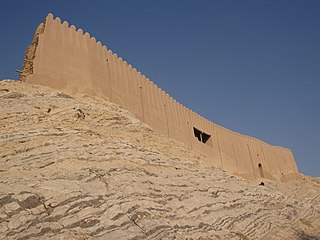The Hephthalites/Gokturk raids of 614-616, were incursions by the Hephthalites and Gokturks into the Sasanian Empire. The Sasanid army led by Smbat Bagratuni quickly defeated the Hephthalites raid who, in response, called the Gokturk Empire for assistance. The Gokturks responded with a large army that raided as far as Ray and the province of Isfahan. The raid was defeated with Smbat killing the Hephthalites leader in single combat.

The Battle of Sallasil, often referred to as the Battle of Chains, was the first battle fought between the Rashidun Caliphate and the Sasanian Persian Empire in April 633. The battle was fought in Kazima by the forces of Khalid ibn al-Walid and the Persians under Hormozd. It was fought soon after the Ridda Wars were over and the Arabian Peninsula was united under the authority of the Caliph Abu Bakr. Indeed, it was the first battle of the Rashidun Caliphate in which the Muslim army elected to extend its frontiers outside of Arabia, thus initiating the Arab conquests.
Jalinus was a 7th-century Armenian dynast, who was one of the leading figures in Sasanian Iran. He was the commander of the guard over Khosrow II, during the latter's imprisonment. Jalinus was a Sasanian commander during the Arab conquest of Iran.
Bahman Jādhūyah/Jādūyah, or Bahman Jādhawayh was an Iranian general of the Sasanians. He is mostly known to have led the Sasanians to victory against the Arabs at the Battle of the Bridge. The Arab Muslims referred to Bahman as Dhul Hājib. He had a reputation for being anti-Arab. He is often confused with Mardanshah, another Sasanian general.

The kanārang was a unique title in the Sasanian military, given to the commander of the Sasanian Empire's northeasternmost frontier province, Abarshahr. In Byzantine sources, it is rendered as chanaranges and often used, for instance by Procopius, in lieu of the holder's actual name.

Spahan, also known as Parthau was a Sasanian province in Late Antiquity, that lay within central Iran, almost corresponding to the present-day Isfahan Province in Iran.
The House of Ispahbudhan or the House of Aspahbadh was one of the seven Parthian clans of the Sasanian Empire. Like the Sasanians, they claimed descent from the Achaemenid dynasty. They also claimed descent from the legendary Kayanid figure Isfandiyar, who was the son of Vishtaspa, who according to Zoroastrian sources was one of Zoroaster's early followers.
Siyavakhsh was an Iranian aristocrat from the House of Mihran who was descended from Bahram Chobin, the famous spahbed of the Sasanian Empire.
Piruz Khosrow, also known as Piruzan or Firuzan, was a powerful Persian aristocrat who was the leader of the Parsig (Persian) faction that controlled much of the affairs of the Sasanian Empire during the Sasanian civil war of 628-632. He was killed at the Battle of Nahāvand in 642.
Mihran-i Bahram-i Razi, better simply known as Mihran Razi, was an Iranian military officer from the Mihran family. He was killed in 637 at the battle of Jalula.
Shahrvaraz Jadhuyih was a Sasanian military officer from the Mihran family. He was related to Shahrbaraz, the Sasanian spahbed and briefly shahanshah. He participated in the battle of Isfahan along with Fadhusfan and another Persian general against the Islamic Arabs. He was, however, defeated and killed during the battle.
The Battle of Waj Rudh was fought in 642/643 between the Rashidun Caliphate under Nu'man, and the Sasanian Empire under the Dailamite Muta, the Parthian Farrukhzad and Isfandiyar, and the Armenian Varaztirots. The battle was fought in Waj Rudh, a village in Hamadan. The location was precisely theorized and occurred on a road junction between Hamadan and Qazvin.
Isfandyadh was an Iranian aristocrat from the Ispahbudhan family, who was the ruler of the Sasanian province of Adurbadagan. He was the son of the powerful Sasanian general Farrukhzad, who was the brother of Rostam Farrokhzad and the son of Farrukh Hormizd.

The Battle of Ray was fought between the Sasanians and the Rashidun Caliphate in 651. It was also part of the rivalry between the Ispahbudhan family and the Mihran family.
The Battle of Badghis was fought in 654 between the Karen family and their Hephthalite allies against the Rashidun Caliphate.
Mihran-i Hamadani, known in Arabic sources as Mihran ibn Mihrbundadh, was a Sasanian military officer from the Mihran family. He was the son of a certain Mihrbandad, who is mentioned in some lines in a poem.
Bukayr ibn Abdallah was an Arab military leader, who served the Rashidun Caliphate and is known for the conquest of the Sasanian province of Adurbadagan.
The Asawira were a military unit of the Rashidun and Umayyad Caliphate. The unit consisted of Iranian noblemen who were originally part of the aswaran unit of the Sasanian army. It was disbanded in 703 by al-Hajjaj ibn Yusuf.
The Battle of Kaskar was fought between the advancing forces of the Rashidun Caliphate and the Sassanian Empire in Asuristan. Following the Battle of Namaraq, the defeated Persian noblemen and governor of Kaškar, Narsi, fled back to his estates in an attempt to save his life. The Muslims soon advanced towards his estate, however, and Narsi marched out to defend it. His flanks were commanded by the sons of Vistahm, Vinduyih and Tiruyih. Rostam Farrokhzad, another Persian noblemen, also sent the commander Jalinus to assist Narsi, but he did not arrive in time. In the ensuring battle, Narsi was soundly defeated, however he and his commanders managed to escape. Jalinus soon met the Muslim force as well, but he too was defeated.

Parvaneh Pourshariati is an Iranian-born American historian of Middle Eastern studies, scholar, and educator. She is an Associate Professor of History at New York City College of Technology (CUNY), and former president of the Association for the Study of Persianate Societies. She specializes in the late antique, early medieval and modern histories of Iran and the Middle East.





